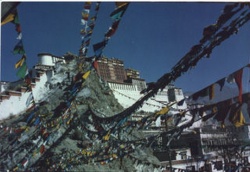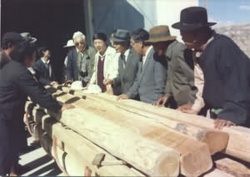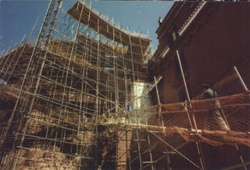Difference between revisions of "To Make the Potala Palace Shine For Ever"
| Line 4: | Line 4: | ||
| − | Tubdain Qamba, 64, wears a [[red]] [[kasaya]]. Outside the [[kasaya]], however, is a blue {{Wiki|uniform}}. He is a [[Lama]], but also a [[Butter lamp]] worker. | + | |
| + | |||
| + | |||
| + | |||
| + | Tubdain Qamba, 64, wears a [[red]] [[kasaya]]. | ||
| + | |||
| + | Outside the [[kasaya]], however, is a blue {{Wiki|uniform}}. | ||
| + | |||
| + | He is a [[Lama]], but also a [[Butter lamp]] worker. | ||
Qamba gets up at seven in the morning, and starts his routine work in The [[Buddha]] halls right after breakfast. | Qamba gets up at seven in the morning, and starts his routine work in The [[Buddha]] halls right after breakfast. | ||
| Line 12: | Line 20: | ||
From eight in the morning to one in the afternoon, Qamba keeps receiving worshippers, who give him butter which he pours into the [[butter lamps]]. | From eight in the morning to one in the afternoon, Qamba keeps receiving worshippers, who give him butter which he pours into the [[butter lamps]]. | ||
| − | |||
| − | While [[lamas]] in [[monasteries]] normally derive income mainly from [[alms]] and [[monastery]] businesses, [[lamas]] in the [[Potala Palace]] each get a monthly salary of 300-500 [[yuan]], plus an annual bonus amounting to 2,000 [[yuan]]. Whenever there is the need to do extra work, each gets five [[yuan]]. | + | In the [[Potala Palace]], there are a total of 57 such [[Butter lamp]] [[masters]]. Unlike [[lamas]] in [[monasteries]], they seldomly get together to recite [[sutras]] and pray for [[blessings]]. |
| + | |||
| + | |||
| + | They are put in charge of a certain number of [[Buddhas]], and the {{Wiki|reception}} of [[pilgrims]] and visitors. | ||
| + | |||
| + | In addition, they are charged with the [[mission]] of looking after {{Wiki|cultural}} [[relics]] and working to prevent theft and [[Fire]] damage. | ||
| + | |||
| + | |||
| + | |||
| + | While [[lamas]] in [[monasteries]] normally derive income mainly from [[alms]] and [[monastery]] businesses, [[lamas]] in the [[Potala Palace]] each get a monthly salary of 300-500 [[yuan]], plus an annual bonus amounting to 2,000 [[yuan]]. | ||
| + | |||
| + | |||
| + | Whenever there is the need to do extra work, each gets five [[yuan]]. | ||
| + | |||
| + | |||
[[Potala Palace]] [[lamas]] enjoy free medicare. | [[Potala Palace]] [[lamas]] enjoy free medicare. | ||
| − | The [[Potala Palace]] is held as the {{Wiki|pride}} and [[symbol]] of the [[Wisdom]] of the industrious [[Tibetans]]. It is a {{Wiki|cultural}} heritage of [[China]] and the [[world]] at large. The Central Government has earmarked huge allocations to repair it. | + | |
| + | The [[Potala Palace]] is held as the {{Wiki|pride}} and [[symbol]] of the [[Wisdom]] of the industrious [[Tibetans]]. | ||
| + | |||
| + | It is a {{Wiki|cultural}} heritage of [[China]] and the [[world]] at large. | ||
| + | |||
| + | The Central Government has earmarked huge allocations to repair it. | ||
[[File:Story_818b.jpg|thumb|250px|]] | [[File:Story_818b.jpg|thumb|250px|]] | ||
| − | |||
| − | |||
| − | The [[Potala Palace]], an almost totally wooden {{Wiki|structure}}, is lit by [[butter lamps]]. This, plus the fluttering {{Wiki|silk}} [[Sutra]] streamers, poses a [[Fire]] hazard. | + | ==[[Potala Palace]] [[Protectors]]== |
| + | |||
| + | |||
| + | |||
| + | |||
| + | The [[Potala Palace]] covers an area of 360,000 square meters, with over 2,000 rooms and 34 [[Buddha]] halls. | ||
| + | |||
| + | Priceless [[treasures]] include the {{Wiki|Holy}} [[Stupa]] for the [[5th Dalai Lama]], which is wrapped up with 5.5 million grams of {{Wiki|gold}} and inlaid with numerous [[gems]]. | ||
| + | |||
| + | Its 10 storehouses contain historical, [[religious]] and {{Wiki|ethnic}} {{Wiki|cultural}} [[relics]]. | ||
| + | |||
| + | |||
| + | |||
| + | The [[Potala Palace]], an almost totally wooden {{Wiki|structure}}, is lit by [[butter lamps]]. | ||
| + | |||
| + | This, plus the fluttering {{Wiki|silk}} [[Sutra]] streamers, poses a [[Fire]] hazard. | ||
| + | |||
| + | |||
| + | |||
| + | The [[Potala Palace]] [[Management]] Administration works painstakingly to prevent accidents. | ||
| + | |||
| + | In 1994, some 4.7 million [[yuan]] was invested to install a TV monitoring system operating 24 hours a day. | ||
| + | |||
| − | |||
Thanks to such efforts, no [[Fire]] has occurred in the {{Wiki|past}} 11 years. And the [[Potala Palace]] found its way into the [[World]] Heritage List on December 7, 1994. | Thanks to such efforts, no [[Fire]] has occurred in the {{Wiki|past}} 11 years. And the [[Potala Palace]] found its way into the [[World]] Heritage List on December 7, 1994. | ||
| − | |||
| − | |||
| − | Repairs conducted in 1989 and 1994 had reinforced the major part of the Palace, but the architectural complex some 2,000 halls calls for regular maintenance. Major efforts should be made to solve the problems of deformation and collapse of walls, and insect infestation of the wooden {{Wiki|structure}}. | + | |
| + | ==[[Exprts? Suggestion]]== | ||
| + | |||
| + | |||
| + | |||
| + | |||
| + | After repair, the [[Potala Palace]] shines more brilliantly atop [[Red]] Hill. | ||
| + | |||
| + | However, as the Palace is hundreds of years old, its maintenance is a [[constant]] agenda item. | ||
| + | |||
| + | |||
| + | According to Qamba Galsang, Director of the [[Potala Palace]] Repair Office, it invited Zhang Zhiping and Yan Hua, {{Wiki|senior}} | ||
| + | |||
| + | engineers with the [[China]] [[State]] {{Wiki|Cultural}} [[Relics]] Research Institute and the [[State]] [[Center]] for the | ||
| + | |||
| + | [[protection]] of {{Wiki|Cultural}} [[Relics]], to conduct an on-the-spot survey in the palace for 20 days. | ||
| + | |||
| + | |||
| + | |||
| + | From this, they made suggestions for its preservation: | ||
| + | |||
| + | |||
| + | |||
| + | Repairs conducted in 1989 and 1994 had reinforced the major part of the Palace, but the architectural complex some 2,000 halls calls for regular maintenance. | ||
| + | |||
| + | Major efforts should be made to solve the problems of deformation and collapse of walls, and insect infestation of the wooden {{Wiki|structure}}. | ||
| + | |||
| + | |||
[[File:Story_818c.jpg|thumb|250px|]] | [[File:Story_818c.jpg|thumb|250px|]] | ||
A team of repair workers be organized. Team members should be [[knowledgeable]] in both construction and design. | A team of repair workers be organized. Team members should be [[knowledgeable]] in both construction and design. | ||
Without changing the [[original nature]] of the {{Wiki|cultural}} [[relics]], efforts be made to reinforce them, such as adding reinforced bars in the walls and hidden {{Wiki|iron}} hooks in wooden beams. | Without changing the [[original nature]] of the {{Wiki|cultural}} [[relics]], efforts be made to reinforce them, such as adding reinforced bars in the walls and hidden {{Wiki|iron}} hooks in wooden beams. | ||
| + | |||
According to the suggestions, carpenters, painters, stonemasons and tailors were organized to repair a dozen projects, and make 500 square meter [[Sutra]] cabinets and 200-odd boxes for {{Wiki|cultural}} [[relics]]. | According to the suggestions, carpenters, painters, stonemasons and tailors were organized to repair a dozen projects, and make 500 square meter [[Sutra]] cabinets and 200-odd boxes for {{Wiki|cultural}} [[relics]]. | ||
| + | |||
“Whitewashing the walls, extending 100 meters or more from top to the ground, calls for more than 50 tons of limestone and [[red]] powder,” said Qamba Galsang. | “Whitewashing the walls, extending 100 meters or more from top to the ground, calls for more than 50 tons of limestone and [[red]] powder,” said Qamba Galsang. | ||
| Line 48: | Line 120: | ||
| − | [[ | + | |
| + | ==[[Potala Palace]]== | ||
| + | |||
| + | |||
| + | |||
| + | The [[Potala Palace]] in the [[Heart]] of old {{Wiki|Lhasa}} was built in the 7th century by [[King]] [[Songtsan Gambo]](617-650),unifiler of Tibet,for his bride,Tang Dynasty(618-907) {{Wiki|Princess}} [[Wencheng]] . | ||
| + | |||
| + | The 13-story palace,the world's highest,stands on a cliff more than 3,700 meters above sea level,and is a rare example of [[traditional]] [[Tibetan]] style architecure. | ||
| + | |||
| + | The original [[Potala]] ,eith 1,000 chambers,was named only after [[Buddhism]] had spread in Tibet."[[potala]]" in [[Sanskrit]] means "[[Buddna's Mountain]]". | ||
| + | |||
| + | |||
| − | + | ==[[Registration of Cultural Relics]]== | |
| − | |||
| + | The [[Potala Palace]] is a huge museum filled with {{Wiki|cultural}} [[relics]]. | ||
| − | + | However, these are not registered and recorded. | |
“This points up to the need to sort out these {{Wiki|cultural}} [[relics]] during the repairs,” said Qamba Galsang. | “This points up to the need to sort out these {{Wiki|cultural}} [[relics]] during the repairs,” said Qamba Galsang. | ||
| − | “Efforts are [[being]] made to register them. [[Thus]] far, we have completed 16 halls and five {{Wiki|cultural}} [[relics]] storehouses, involving 60,000 [[relics]] in over 5,000 archives. | + | “Efforts are [[being]] made to register them. |
| + | |||
| + | [[Thus]] far, we have completed 16 halls and five {{Wiki|cultural}} [[relics]] storehouses, involving 60,000 [[relics]] in over 5,000 archives. | ||
“Recently, we are doing the work on the six storehouses of bronzeware, {{Wiki|ceramics}}, [[tangka]] paintings, classics, garments and others. | “Recently, we are doing the work on the six storehouses of bronzeware, {{Wiki|ceramics}}, [[tangka]] paintings, classics, garments and others. | ||
| Line 71: | Line 156: | ||
“We have also published a pictorial showing the {{Wiki|history}}, [[architecture]] and {{Wiki|cultural}} [[relics]] of the [[Potala Palace]].” | “We have also published a pictorial showing the {{Wiki|history}}, [[architecture]] and {{Wiki|cultural}} [[relics]] of the [[Potala Palace]].” | ||
| + | |||
| + | |||
| + | |||
| + | |||
| + | |||
| + | |||
| + | |||
| + | |||
[[Category:Buddhist Terms]] | [[Category:Buddhist Terms]] | ||
[[Category:Tibetan Buddhism]] | [[Category:Tibetan Buddhism]] | ||
[[Category:Potala]] | [[Category:Potala]] | ||
Latest revision as of 17:51, 20 May 2019
Tubdain Qamba, 64, wears a red kasaya.
Outside the kasaya, however, is a blue uniform.
He is a Lama, but also a Butter lamp worker.
Qamba gets up at seven in the morning, and starts his routine work in The Buddha halls right after breakfast.
He is responsible for drawing up the curtains, cleaning the halls and adding butter to the butter lamps in front of statues of Buddha.
From eight in the morning to one in the afternoon, Qamba keeps receiving worshippers, who give him butter which he pours into the butter lamps.
In the Potala Palace, there are a total of 57 such Butter lamp masters. Unlike lamas in monasteries, they seldomly get together to recite sutras and pray for blessings.
They are put in charge of a certain number of Buddhas, and the reception of pilgrims and visitors.
In addition, they are charged with the mission of looking after cultural relics and working to prevent theft and Fire damage.
While lamas in monasteries normally derive income mainly from alms and monastery businesses, lamas in the Potala Palace each get a monthly salary of 300-500 yuan, plus an annual bonus amounting to 2,000 yuan.
Whenever there is the need to do extra work, each gets five yuan.
Potala Palace lamas enjoy free medicare.
The Potala Palace is held as the pride and symbol of the Wisdom of the industrious Tibetans.
It is a cultural heritage of China and the world at large.
The Central Government has earmarked huge allocations to repair it.
Contents
Potala Palace Protectors
The Potala Palace covers an area of 360,000 square meters, with over 2,000 rooms and 34 Buddha halls.
Priceless treasures include the Holy Stupa for the 5th Dalai Lama, which is wrapped up with 5.5 million grams of gold and inlaid with numerous gems.
Its 10 storehouses contain historical, religious and ethnic cultural relics.
The Potala Palace, an almost totally wooden structure, is lit by butter lamps.
This, plus the fluttering silk Sutra streamers, poses a Fire hazard.
The Potala Palace Management Administration works painstakingly to prevent accidents.
In 1994, some 4.7 million yuan was invested to install a TV monitoring system operating 24 hours a day.
Thanks to such efforts, no Fire has occurred in the past 11 years. And the Potala Palace found its way into the World Heritage List on December 7, 1994.
Exprts? Suggestion
After repair, the Potala Palace shines more brilliantly atop Red Hill.
However, as the Palace is hundreds of years old, its maintenance is a constant agenda item.
According to Qamba Galsang, Director of the Potala Palace Repair Office, it invited Zhang Zhiping and Yan Hua, senior
engineers with the China State Cultural Relics Research Institute and the State Center for the
protection of Cultural Relics, to conduct an on-the-spot survey in the palace for 20 days.
From this, they made suggestions for its preservation:
Repairs conducted in 1989 and 1994 had reinforced the major part of the Palace, but the architectural complex some 2,000 halls calls for regular maintenance.
Major efforts should be made to solve the problems of deformation and collapse of walls, and insect infestation of the wooden structure.
A team of repair workers be organized. Team members should be knowledgeable in both construction and design.
Without changing the original nature of the cultural relics, efforts be made to reinforce them, such as adding reinforced bars in the walls and hidden iron hooks in wooden beams.
According to the suggestions, carpenters, painters, stonemasons and tailors were organized to repair a dozen projects, and make 500 square meter Sutra cabinets and 200-odd boxes for cultural relics.
“Whitewashing the walls, extending 100 meters or more from top to the ground, calls for more than 50 tons of limestone and red powder,” said Qamba Galsang.
Potala Palace
The Potala Palace in the Heart of old Lhasa was built in the 7th century by King Songtsan Gambo(617-650),unifiler of Tibet,for his bride,Tang Dynasty(618-907) Princess Wencheng .
The 13-story palace,the world's highest,stands on a cliff more than 3,700 meters above sea level,and is a rare example of traditional Tibetan style architecure.
The original Potala ,eith 1,000 chambers,was named only after Buddhism had spread in Tibet."potala" in Sanskrit means "Buddna's Mountain".
Registration of Cultural Relics
The Potala Palace is a huge museum filled with cultural relics.
However, these are not registered and recorded.
“This points up to the need to sort out these cultural relics during the repairs,” said Qamba Galsang.
“Efforts are being made to register them.
Thus far, we have completed 16 halls and five cultural relics storehouses, involving 60,000 relics in over 5,000 archives.
“Recently, we are doing the work on the six storehouses of bronzeware, ceramics, tangka paintings, classics, garments and others.
“In the meantime, we have set up a special office for research. Scholars have been organized to make catalogues of 2,500 classics.
“Thus far, we have published the Catalogue on the Gelug Sect Classics and the Catalogue on the Nyingma Sect Classics.
“We have also published a pictorial showing the history, architecture and cultural relics of the Potala Palace.”


